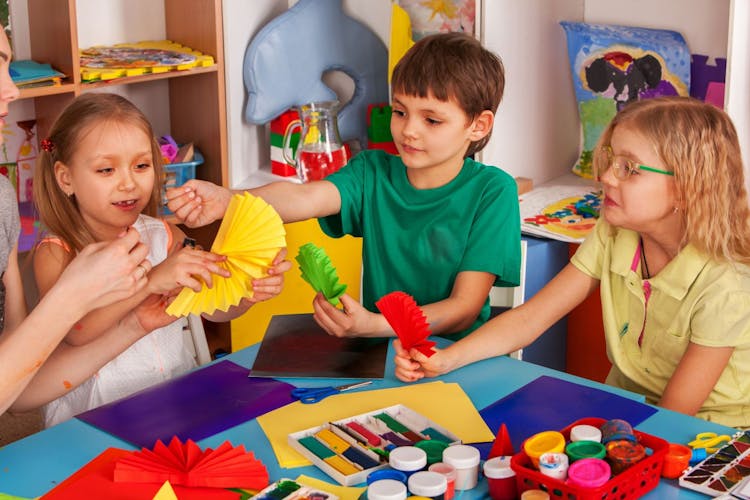Fine motor skills start to develop when a child uses the smaller muscles in their hands, wrists, fingers, feet, and toes. Developing those muscles includes actions like grasping, holding, pressing, or using a pincer grip (holding something between the fore-finger and thumb).
For young children of preschool, kindergarten, and early school age, fine motor skill development is extremely important. Try making one of these 7 things with them.
Why are fine motor skills important?
Fine motor skills are vital for doing everyday activities like buttoning up a shirt, using utensils to eat, tying shoelaces, cutting with scissors, and writing. As adults, we use fine motor skills so often in our daily lives that it’s easy to not realize that the task we are completing requires a certain skill set and the use of certain muscles.
If a young child is unable to do these everyday tasks, it can affect their self-confidence, ability to develop self-care and independence skills, and also their academic performance.
7 ways parents can help children develop and improve their fine motor skills
These 10 techniques are especially effective for teaching preschool or kindergarten-aged children fine motor skills, but they are also necessary and useful for younger and older children’s motor skill development.
Parents can encourage and help kids to improve their fine motor skills with simple, fun activities. If you’re stuck for ideas, try a few of the activities below.
1. Play-dough
Tactile play with good old favorite materials like play-dough is a great way for kids to experiment and build fine motor skills. To make this even more interesting you could make the play-dough with your child first before they play with it. Here’s a video that shows you how to make your own play dough.
2. Puzzles
Do puzzles together. Picking up and moving puzzle pieces into place helps develop a pincer grasp.
Watching or helping your child learn how to complete a puzzle can sometimes be frustrating, they can be impatient and give up easily, lose pieces, or put them in their mouth. But if you stick with it the rewards are worth it. Engage with and encourage your child as much as you can compete for easy puzzles at first and then progressively harder ones, doing this will improve their hand-eye skills, coordination, and motor skills.
Watching the smile and sense of satisfaction that your child will get from completing a puzzle provides tremendous satisfaction for parents.
See the top-rated puzzles for kids here.
3. Drawing, coloring in, and painting
Encourage your child to draw and paint. This helps not only they are fine motor skills, but also creativity and imagination too. Try different types of painting and different mediums, like crayons, chalk, finger paints, brush painting, or charcoal, to spark their interest and strengthen your child’s hand-eye coordination. Painting with a paintbrush helps kids learn to hold a brush and gain greater control using things in their hands including pencils and other items. Paint-by-number can be an excellent form of brush painting for young children, Faber-Castell does an excellent version here.
4. Cutting with scissors
Using scissors is a great way to strengthen fine motor skills as well as improve hand-eye coordination and concentration. You can draw shapes for your child to cut around. Make some paper snowflakes. Even cut play-dough. Make sure you use age-appropriate scissors.
Why not try making this fine motor skills man with your child? Here’s how.
5. Bath time play
Use cups to fill and pour out sponges, or squeaky rubber toys to squeeze. Try not to stress about water going on the floor, you can always wipe it up afterward
6. Build with blocks and Lego
Stack, connect, and build things together with blocks and Lego. These activities encourage fine pushing and pulling movements. Lego is also great for fostering creativity. Building with LEGO is an effective way to work and develop your child’s fine motor skills. As children build and even pick up LEGO pieces they will, build stronger muscles in their hands and improve coordination, this will help them to improve other skills, such as learning to hold a pencil and learning to write.
Other skills children can learn from playing with Legos include persistence, a sense of accomplishment, and an improved ability to solve puzzles.
7. Threading and lacing
Thread different size pasta or beads onto strings, laces, and pipe cleaners. Tie knots and bows in the string. Finger knitting is easy and fun too!
Learning to brush your teeth is good for your child’s motor development
It can be difficult to teach young children to brush their own teeth, especially to get them to brush properly, but doing so will help their fine motor skills development. Click here to learn 10 ways to improve your child’s teeth hygiene and improve their teeth brushing competency.
What to do if you’re concerned
Issues with coordination and balance may not be noticeable until kids reach school age. But if you’re concerned about your child’s gross motor skills, we have Southern Pediatric Therapy Clinic which can help. Our specialists support preschool kids and their families to develop basic sensory awareness and motor skills to help them with self-care skills and get ready for school. Call (769) 242-2139 to make an appointment.


